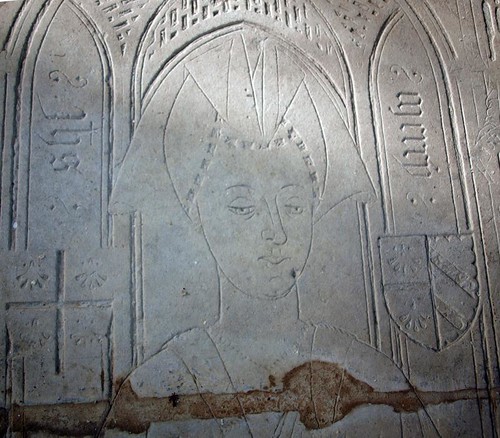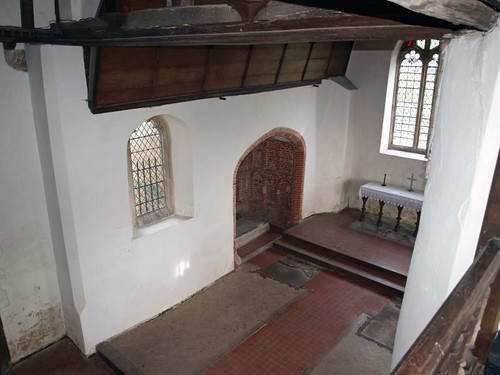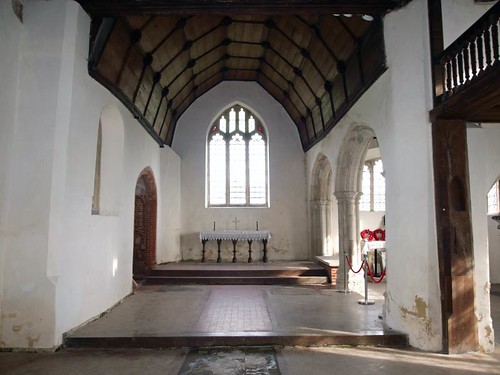Cruciform, both transepts are galleried, it sits alone overlooking the A127 and is truly stunning. Of particular note is Alice Tyrell's, d. 1422, incised monumental slab and Thomas Tyrell's C15 chancel tomb recess.
The Friends of All Saints East Horndon have a full description and history here.
ALL SAINTS. Brick church, all alone on a hill just N of an arterial road. Eminently picturesque short C17 W tower with thick diagonal buttresses, continued in polygonal angles and polygonal pinnacles. The battlements between these are stepped. Large arched windows as bell-openings, with raised frames. The rest of the church is C15 to early C I6. It has - an unusual feature - N and S transepts. Charming group of S Porch and S Transept under one sloping roof leading up to a gable, and then projecting S chancel chapel. Inside, this chapel is separated from the chancel by a two-bay arcade with a pier of four demi-shafts and four diagonal hollows and moulded arches. In the N chancel wall a deep recess brick-panelled at the back and containing the MONUMENT of Sir Thomas Tyrell d. 1476 with C19 tomb-chest on which now only the Brass to Lady Tyrell. Excellent roofs, flat-ceiled in the S chapel, pitched and ceiled with panels separated by bosses in the chancel, open with tie-beams and king posts in the nave. Balconies or Galleries divide the narrow transepts into two storeys. They date from the early C17. - FONT. Square, of c. 1200, with flat sunk decoration of interlaced arcade on two sides, and foliated crosses on the other. - PULPIT. Plain, C17. - HELMS, GAUNTLETS, and SWORD of the Tyrell Family. - MONUMENTS. Sir Thomas Tyrell, see above. - Lady Tyrell d. 1422, large incised limestone slab with figure in horned head-dress under canopy with figures of children up to l. and r. shafts. - Unknown family, c. 1520, in recess in S transept. Tomb-chest with quatrefoil decoration, brasses against the backwall; only the man survives; the indent shows that he and his wife were praying to the Trinity. - Sir John Tyrell d. 1766. With two cherubs’ heads at the foot, inscription, and higher up urn against an obelisk. Signed by Nollekens.
EAST HORNDON. It is one of the places where the head of Anne Boleyn is said to lie, but we do not know; the story is that it was brought here for burial after the Calais headsman had severed it from her frail body. If the tale is true the head will lie in the red brick church on the brow of a hill which rises steeply by the Southend road. The church’s bricks are very old, the chancel and its small chapel, the nave, and the two-storeyed transepts being 15th century, while the big chapel, the porch, and the tower are Tudor. The low tower owes its curiously stepped battlements to the men who set it up after it had fallen down 300 years ago. An odd feature of the church is an upper room in each transept; open to the church, they were the dwelling-rooms of the priest for over a century.
At the square Norman font the Tyrells were baptised for hundreds of years, one to grow up to fight for Henry the Fifth at Agincourt and to be three times Speaker, and another to suffer for his loyalty to Charles Stuart. There is a beautiful portrait of the wife of the Tyrell of Agincourt, cut by a master hand in grey stone on her tomb. In a few sweeping strokes the artist has drawn her restful and dignified face and form, giving her a horned headdress and a fur-lined cloak. On the shafts of her vaulted canopy are portraits of her ten children, each with the Christian name. One of these boys was the Thomas who lies in the small chapel on the other side of the chancel. His brass portrait has gone but his wife’s remains. Were they the parents of the man who lies in the altar tomb in the transept? His brass shows him in armour and here are the brasses of his eight sons, but his name is lost. In the chapel lies the Royalist Sir John Tyrell, his gravestone recording how he was “once decimated, twice imprisoned, and thrice sequestrated,” the first and last phrases, of course, referring only to his estates! The Tyrell arms are in 15th century glass in the east window of this chapel and two of their helmets have been here since the 16th century. The panelled chancel roof has bosses carved with flowers, birds, and shields; there are two poppyheaded bench-ends and a fine door 400 years old; and the carved pulpit is 17th century.
Paths across the fields lead from this lonely place towards the Tyrell home at Herongate and to East Horndon Hall, now a farm rich in oak beams.
Simon K -
You come to it by an unsigned track from the dual carriage way, and
then a half mile path across scrub land. If it hadn't been for the
'church open' sign on the back road I would not have approached it -
it looks too forbidding, dangerous even. But it is a beautiful red
brick exterior when you get to it, and the interior is haunting.
Everything is preserved beautifully in the CCT manner, and during the half hour I was here there were several other visitors, all walkers who had made their way up from the country park below. This is the kind of church which will not make its way into anyones top hundred, but is utterly memorable. I was so glad I'd found it.
At the square Norman font the Tyrells were baptised for hundreds of years, one to grow up to fight for Henry the Fifth at Agincourt and to be three times Speaker, and another to suffer for his loyalty to Charles Stuart. There is a beautiful portrait of the wife of the Tyrell of Agincourt, cut by a master hand in grey stone on her tomb. In a few sweeping strokes the artist has drawn her restful and dignified face and form, giving her a horned headdress and a fur-lined cloak. On the shafts of her vaulted canopy are portraits of her ten children, each with the Christian name. One of these boys was the Thomas who lies in the small chapel on the other side of the chancel. His brass portrait has gone but his wife’s remains. Were they the parents of the man who lies in the altar tomb in the transept? His brass shows him in armour and here are the brasses of his eight sons, but his name is lost. In the chapel lies the Royalist Sir John Tyrell, his gravestone recording how he was “once decimated, twice imprisoned, and thrice sequestrated,” the first and last phrases, of course, referring only to his estates! The Tyrell arms are in 15th century glass in the east window of this chapel and two of their helmets have been here since the 16th century. The panelled chancel roof has bosses carved with flowers, birds, and shields; there are two poppyheaded bench-ends and a fine door 400 years old; and the carved pulpit is 17th century.
Paths across the fields lead from this lonely place towards the Tyrell home at Herongate and to East Horndon Hall, now a farm rich in oak beams.
Simon K -
This is a bleak location on a heathland hill directly above a major
junction on the A127 London to Southend dual carriageway. Redundant in
1965, it suffered what has been described as 'an unprecedented and
violent serial attack of vandalism' in the late 1960s before being
rescued by the CCT. No internal furnishings survive.
Everything is preserved beautifully in the CCT manner, and during the half hour I was here there were several other visitors, all walkers who had made their way up from the country park below. This is the kind of church which will not make its way into anyones top hundred, but is utterly memorable. I was so glad I'd found it.



No comments:
Post a Comment